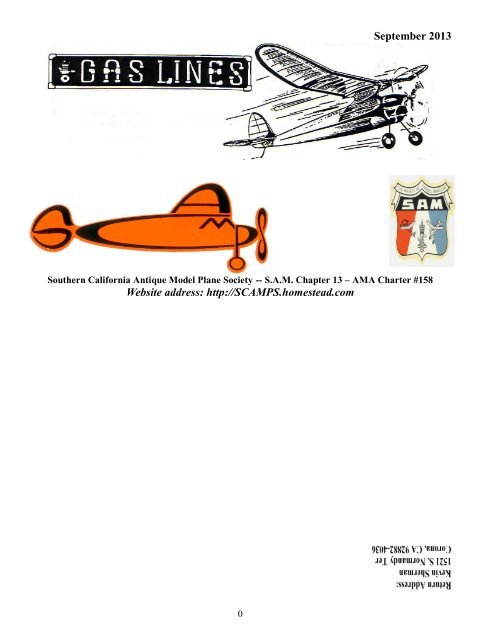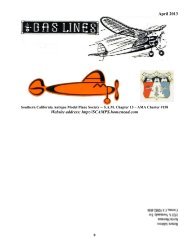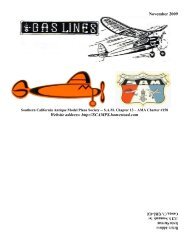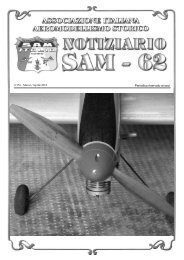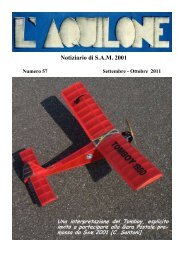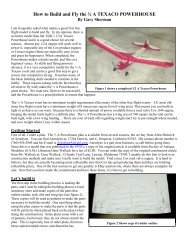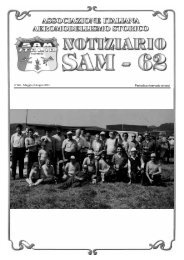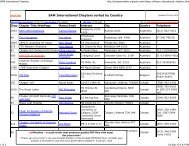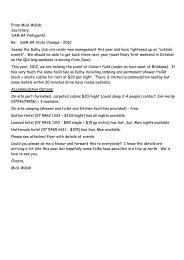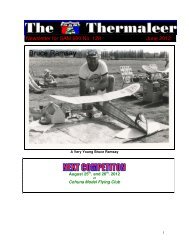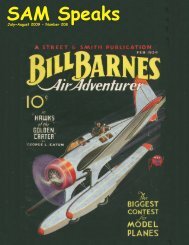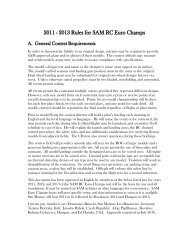Southern California Antique Model Plane Society – Sam 13
Southern California Antique Model Plane Society – Sam 13
Southern California Antique Model Plane Society – Sam 13
You also want an ePaper? Increase the reach of your titles
YUMPU automatically turns print PDFs into web optimized ePapers that Google loves.
September 20<strong>13</strong><br />
<strong>Southern</strong> <strong>California</strong> <strong>Antique</strong> <strong>Model</strong> <strong>Plane</strong> <strong>Society</strong> -- S.A.M. Chapter <strong>13</strong> <strong>–</strong> AMA Charter #158<br />
Website address: http://SCAMPS.homestead.com<br />
0
AMA 158 <strong>–</strong> <strong>Southern</strong> <strong>California</strong> <strong>Antique</strong> <strong>Model</strong> <strong>Plane</strong> <strong>Society</strong> <strong>–</strong> <strong>Sam</strong> <strong>13</strong><br />
SCAMPS Officers<br />
President Daniel Heinrich (909) 593-5789 AeronutD@cs.com<br />
Vice President George Walter (714) 528-0774 GeorgeWalter@alumni.pitt.edu<br />
Secretary/Treasurer Kevin Sherman (951) 737-7943 Julykevin@aol.com<br />
Editor Clint Brooks (562) 493-2749 scampsedit@Yahoo.com<br />
Meeting Coordinator Mark Williams (909) 996-2942 marknjeannie@gmail.com<br />
Safety Officer Ted Firster (951) 776-4971 Civyboy31@aol.com<br />
September SCAMPS Meeting Location<br />
The SCAMPS’ September meeting will be held Saturday September 21st at Dr. Don and Mary Chapton’s home<br />
located at 43705 Paisano Place near the City of Temecula. A luncheon is planned starting 1 PM and the ladies are<br />
invited to attend. Directions: you need to take the 215 or 15 South to Temecula. Take the 79/Warner Springs<br />
exit on the Temecula Parkway East to Margarita Road and turn left-go north past De Portola Road until you<br />
come to Jededia Smith Road and turn left. Follow this West until you meet Paisano Place and turn left. The<br />
Chapton’s house is at the end of the drive with an iron gate in front. See you there!<br />
1
SCAMPS NEWS<br />
by Clint Brooks<br />
It’s been a busy summer-the Boomer Mark III upgrade has taken a new urgency as customers are asking for it<br />
ASAP. I’ve gotten it pretty far down the road and have built one test prototype (T-1) which I have already<br />
lost due to timer fumbling at the launch in Costa Mesa last weekend. A lovely long journey to the north over<br />
the Santa Ana river bed saw it disappear into suburbia beyond. Join your lost brothers fair Boomer! Not to<br />
be deterred, the T-2 version is already built and will appear in living color on my website in the construction<br />
picture collection that will be there for builders and would be builders. My design goals of manufacturing<br />
improvement and weight reduction were both achieved-the ready to fly model sans motor is 37.4 grams.<br />
Rather than try and add weight (UGHH) to make the minimum 40 gram allowable, I’ll leave some ceiling for<br />
builders to do what a lot do-build overweight by adding stuff. If I were you, the weight margin is perfect for<br />
a tracker pellet installation..or radio D/T. Things that are different-longer fuselage tube section, simplified<br />
stab platform and elimination of the self keying notch feature in the horizontal stab. Pylon is shorter length<br />
for a fixed wing position predicated<br />
on the integrated wing pop-up D/T<br />
system. I’m also going to provide<br />
this model as turnkey with a<br />
Gizmogeezer freewheeler front end<br />
and Badge Classic viscous timer as<br />
standard equipment. T-1 flew<br />
literally off the board with tiny<br />
adjustments required for thrust<br />
only-I had set the stab as neutral as I<br />
could eyeball and it just flew as if I<br />
had already spent a few sessions<br />
working it in. Out of the box, it<br />
should be lean and mean and ready<br />
to win!<br />
Continuing to speak of the Boomer, I<br />
have a win-win situation for those<br />
who may have an overweight<br />
version-read on….<br />
Boomer Mark III T-1 before if was given up to the wilds of Huntington Beach CA<br />
Many of you know Dick Baxter as a respected free flighter and aeronautical engineer of some repute.<br />
Luckily for the Costa Mesa Dog Park FF crowd, Dick frequents the area most every weekend with his<br />
flapping wing creations and other aeronautical oddities. I think his interests are not so much making things<br />
of beauty that fly well, but rather solve aeronautical problems that interest him in general. Dick is very<br />
interested in what happens on wings at the tips-he is one of the many intrigued on the efficiency of winglets<br />
and soaring bird wing tip feathers and the advantages they offer to these amazing creatures-particularly<br />
raptors.<br />
2
Earlier this year he built a Boomer wing that<br />
was stock at the center, but the tip panels were<br />
modified into a series of feathers similar to an<br />
owl or hawk wing tip. This was done so we<br />
could test this wing against a stock Boomer<br />
wing for any signs of improved performance.<br />
We did this reasonably carefully at the dog<br />
park-making a series of test flights over several<br />
weekends to see what would happen in the<br />
comparison. What was surprising was the<br />
modified wing worked about the same as the<br />
stock wing, although I think in the end it did<br />
not offer longer glide duration under the<br />
outside conditions. The tip feathers were very<br />
crudely rendered however, and subject to much<br />
refinement for shaping and incidence, etc.<br />
But it was damn interesting to perform the tests, and the wing grabbed lots of attention when flown. As you<br />
can see in the picture, Dick added some tufts to try and understand the effectiveness of this configuration as far<br />
as where the tip vortices would manifest. Ho-hum you say..why would anyone care about that?<br />
Well, to most of us FF laymen (me included) we presume a wing is effective for lift production over the full<br />
span. And I don’t think we give much thought to the wing tip shape either-mostly it’s based on what is best<br />
for building and not so much for aerodynamic consideration. And in reality, that fills the bill for the most<br />
part and doesn’t cause us to lose sleep at night thinking about it.<br />
Well, if you want to maximize the performance of a wing for a given span, understanding where the tip<br />
vortices begin to form can be very useful. And according to Dick’s explanation to me-wherever it forms, any<br />
wing area outboard of that point is not doing very much to contribute to the lift of the wing, thus reducing the<br />
effective wing span to the point the turbulence begins. Really? What does that mean?<br />
Well, it means your wing is not doing work for the extra structural weight that exists beyond that point. So<br />
what the heck now Holmes? Keep reading….<br />
Dick provided me with a tool to find this magic turbulence break point. It’s a simple rotor device that<br />
resembles a small pinwheel except the blades are fully feathered with respect to the airstream. And that’s<br />
how it detects where the tip vortices starts-so long as the airflow is coming straight back off the wing in a<br />
laminar fashion, the rotor remains motionless in flight as mounted to the trailing edge of the wing. This part<br />
of the wing is doing the job of providing lift, and it likely doing so all the way back to the intersection of the<br />
wing to the fuselage or whatever is holding it. So by moving the rotor toward the tip along the trailing edge,<br />
eventually you begin to detect rotation. This is due to the<br />
turbulent airflow now coming off the wing based on some span<br />
wise airflow that is heading to the wing tip vortices formed<br />
when the wing moves though the air. The rotor is now taking<br />
air hitting on the sides of the blades, causing it to move. If you<br />
mount one on each wing tip they will rotate in opposite<br />
directions-cool huh?<br />
Well, the disappointment is to note this starts to happen well<br />
before the actual tip of the wing, at least on the Boomer-about<br />
where shown (see left). Hmmm-that means the glide ratio<br />
offered by this wing at 30 inch span is being compromised by<br />
3
this turbulent flow-so is there anything that can be done to help? Probably, and that is what Dick and his<br />
funny wing tip design are trying to determine in an elegant way. For an immediate solution to improve the<br />
Boomer wing (or any wing really) the fix is to have the trailing edge longer than the leading edge of the wing.<br />
The stock Boomer wing is already sorta like that, but Dick suggested around 40 degrees of rake in the tip to<br />
really exploit the characteristic.<br />
Okay-thanks! I developed a quick Boomer wing tip mod for 40 degrees, sawed off an existing wing and<br />
added a new tip to test this theory. Next weekend at the dog park I resumed rotor testing the modified wing,<br />
starting with the same location the turbulent flow was detected on the stock configuration. No observable<br />
movement of the rotor at this location-interest began to grow. Dick and I moved the rotor outboard in ¼ inch<br />
increments to within probably ½ inch from the<br />
pointy tip, still no movement. Now the master<br />
himself began questioning the validity of the process<br />
so I placed the rotor at the very end of the pointy<br />
wing tip and gave another short flight. Lo and<br />
behold, it was spinning-the very pointy tip was<br />
where the vortices was forming-exactly where you<br />
want it and likely very small too. BINGO-nailed it<br />
for a 40 degree raked tip. Is that much really<br />
required? I don’t know, but it was fun to see the<br />
problem so well solved with this simple<br />
configuration, which removed a considerable chunk<br />
of structure from the wing tip panel. Full power<br />
flight testing followed with lift developing in the<br />
area-it was impossible to detect any difference in<br />
performance between this wing and a stock one<br />
flown on the same fuselage by altering between<br />
flights.<br />
To further understand any performance changes, I waited until one very calm evening at dusk and went to the<br />
park near my house with both wings and one fuselage setup with a motor, etc. I weighed both wing<br />
configurations and ballasted the airplane for the wing weight difference for glide tests. From a small hill I<br />
glided each wing six times, alternating wings between flights for a total of 12 flights. It was still hard to<br />
visually detect any obvious performance advantage, but when comparing the time data the modified wing<br />
appeared to offer a 2.5% glide performance improvement over the stock wing. That’s not really a lot to<br />
thump your chest about, but it was a measurable difference which surprised me.<br />
So to get back to the earlier part of this column about having a heavy Boomer on your hands-you can save<br />
about .9 grams of weight by raking the wing tips 40 degrees. This is a weight savings that also translates into<br />
a performance gain not only in lighter weight for climb and sustained flight, but improved glide ratio from<br />
reduced wing tip drag. That folks is a WIN-WIN situation and why you should come to the dog park for aero<br />
engineer training from the master-Dick Baxter!<br />
August SCAMPS Club Contest<br />
by Gary Sherman<br />
After having a very mild summer so far, our August contest was held on what seemed like a hot day. It was<br />
well under 100 degrees but standing out in a field and flying always makes the temperature seem more<br />
extreme, and most flyers were packed up and leaving when the contest ended at 11:00 am. Even though it<br />
was a warm day, there seemed to be some pretty good lift and especially buoyant air early in the morning.<br />
After about 9:30, the air became spotty, but those who were doing a good job of picking air still did well.<br />
4
Participation last month was very light, so I did not know what to expect for the August event. I am pleased<br />
to report that each event, ½ A <strong>–</strong> C Nostalgia Gas for power and Large Old Timer Rubber Combined was hotly<br />
contested. Nostalgia Gas seems to be the hottest area of interest these days, and today just further confirmed<br />
that with 7 contestants taking flights. Kevin Sherman showed the way with his Veco 19 powered Spacer<br />
posting 5 maxes (total flight time 900 seconds) for the win. He got off to a bit of a late start because he went<br />
and picked up Bob Goldie to bring him out to<br />
the flying field. He helped me set up the shade<br />
and CD table, and then headed off to get Bob.<br />
Bob is doing great and a lot of people were sure<br />
happy to see him. It has been far too long!<br />
Ray Peel also maxed out with his C size Texan<br />
(see right), but on his first fly-off flight<br />
committed the cardinal sin of DTing early and<br />
was just seconds short of maxing. This is<br />
exactly why the club contests were started, so<br />
guys could become more proficient at contest<br />
flying at a small casual meet, and hone their<br />
skills for when they go to big contests. The<br />
breeze was light all day and most models landed<br />
right by the launch area, so there was no reason<br />
to cut it close on the fuse and I think Ray was<br />
beating himself up over it. So, commit that one<br />
to the memory bank! Ray was certainly not the first to do this and won’t be the last. This brought back<br />
something Sal Taibi mentioned to Kevin and I years ago; the way to win a contest is to eliminate your<br />
mistakes. He was so right. Regardless, the 3 maxes and near max in the fly-off netted Ray Peel a second<br />
place finish with a total of 716 seconds. Not sure why, but Ted Firster also got off to a late start flying his Fox<br />
powered Lucky Lindy. On his first flight, he shorted himself significantly on the motor run, with less than a<br />
9 second run, but caught some decent air and with the great Lindy glide, he easily maxed. On his second<br />
flight, again the motor run was woefully short and even though the Lindy glides better than most Nostalgia<br />
models, was unable to duplicate the success of his first flight, and posted 159 seconds. Oddly, his third<br />
flight got a much better engine run, but it was his shortest flight with 154 seconds. Ted ended up in third<br />
place with a total of 458 seconds. Rounding out the field was Phil Ronney flying one of his Champions, and<br />
a total of 458 seconds for fourth place. John Riese went from the dentist chair to a fifth place with his Spacer<br />
and a total of 456 seconds. Jeff Carman must have had some trouble with his Texan, and only took two<br />
flights for a total of 203 seconds and sixth place.<br />
Al Richardson has just started trimming a Zeek,<br />
but decided to participate. He also took two<br />
flights and posted 118 seconds for seventh place.<br />
I saw Al putting in more flights after the contest<br />
and the model was really starting to go.<br />
5<br />
I guess the word did not get out to a few that the<br />
Red Buzzard was the plane to fly today in the<br />
rubber event, so having to be different, Bernie<br />
Crowe brought his trusty Lamb Climber and Al<br />
Richardson flew his Eugene. The rest of the<br />
field was made up of George Walter, Hal<br />
Wightman and Fernando Ramos flying; well you<br />
guessed it, Red Buzzards. Most of the posted<br />
flights were maxes or near maxes. Posting two
maxes and one flight 10 seconds short, George Walter bested the rest for the win with a total of 530 seconds.<br />
Hal Wightman also posted two maxes, but his third flight was 127 seconds. The total of 487 seconds got Hal<br />
a second place finish. I guess George had bragging rights in their ride home. Also posting two maxes and<br />
non-max flight of 106, Al Richardson placed third with a total of 466 seconds. Bernie Crowe missed his first<br />
max by two seconds, when his model flew out of site behind the cars, and the timer was unable to see it to the<br />
ground. Would have probably made it, but the flight netted him 178 seconds. He followed that with a max,<br />
and an “Other” (actually it was 96 seconds) for a fourth place finish and a total of 454 seconds (that total<br />
reminds me of a big block Chevy!). Fernando Ramos put in just one flight with his Red Buzzard. The climb<br />
was great hitting some nice air on the way up. But after the prop fold, the model failed to have a glide circle<br />
and flew out of the lift and into some down air. He still nearly made his max with a time of 164 seconds,<br />
netting him a fifth place finish.<br />
Thanks to all who participated.<br />
Fernando Ramos launches his rubber powered twin North<br />
American OV-10A Bronco. CDF flies these as fire<br />
spotters/air tanker coord out of Hemet-Ryan just to the east<br />
of Perris..<br />
6
That’s about it for this month-don’t forget the 43 rd United States Free Flight Champs happening at Lost Hills<br />
September 27 th through 29 th . Below is the schedule of events:<br />
43rd U.S. FREE FLIGHT CHAMPIONSHIPS<br />
LOST HILLS, CA 09/27-29/20<strong>13</strong><br />
American and National Cup<br />
7 FAI Events<br />
16 Old Time Events<br />
10 Nostalgia & Classic Events<br />
15 Modern AMA Events<br />
3 Flying Aces Events<br />
2 Compressed Air Events<br />
All Entrants receive a Tee Shirt<br />
ALL CASH AWARDS over $5000 purse<br />
1st $75, 2nd $50, 3rd $25<br />
(less than 4 entrant’s awards reduced)<br />
Sweepstakes $150<br />
3 Division Championships $75 each:<br />
(Modern, Nostalgia/Classic, Old Timer)<br />
Plus perpetual trophy events<br />
Jr. Awards in all Events<br />
1st $25, 2nd $15, 3rd $10<br />
Information contact: Ted Firster Civyboy31@aol.com<br />
951-776-4971 or cell 951-830-0414<br />
See website for information<br />
LHFFMAA.COM<br />
7
SCAMPS 20<strong>13</strong> Club Contest Calendar of Events<br />
Mo Day Rubber<br />
Power CD<br />
Sep 11 Coupe (F1G) / HLG / CLG OT ABC Combined F. Ramos<br />
Oct 16 Nos Wake / Nos Rubber F1Q / E36 / Harbor Fr. B. Crowe<br />
Nov <strong>13</strong> P-30 / Jimmy Allen<br />
1/2A - D AMA Gas G. Walter<br />
Dec 11 Gollywock Mass Launch + 1/2A - C Nostalgia Gas A. Richardson<br />
OT Small Rubber (comb)<br />
8


